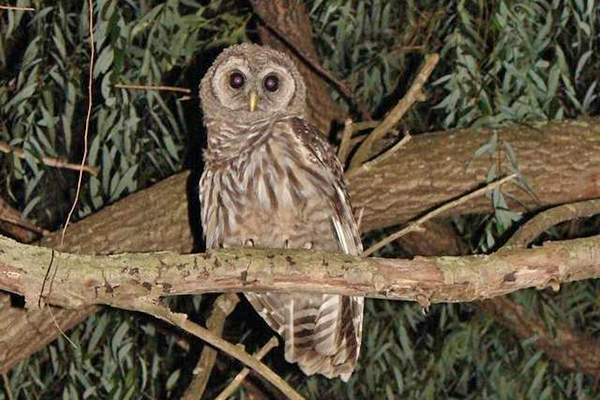
Native Delaware: Owls
Owl breeding season has begun in Delaware
8:59 a.m., Jan. 29, 2013--Heard any owls lately? Maybe you’ve seen one of these elusive raptors perched on its nest.
If so, please tell Jean Woods.
Campus Stories
From graduates, faculty
Doctoral hooding
Woods is the curator of birds for the Delaware Museum of Natural History, one of the organizations supporting the Delaware Breeding Bird Atlas. The atlas is a five-year, state-led project to determine the area bird population and assess any changes since the last atlas, which was held 20-plus years ago.
Data gathering for the atlas was supposed to end in 2012 but there was a bit of a problem, says Woods, who sits on the project’s technical committee. Well, make that a big problem, at least when it comes to owls.
“We discovered that we didn’t have enough data on the nocturnal birds, especially owls,” she says. “We extended the atlas into 2013 to try to get some additional information.”
Woods is eager to hear from birders or, anyone, frankly, who has heard or seen an owl recently. It can be hard to distinguish the sounds – or sight – of many of the state’s shore and marsh birds. But it’s pretty easy to identify the calls of Delaware’s owls. Their hoots are distinct, and there are only a handful of species in the state.
This is a great time to listen for owls. The end of January marks the start of the breeding season so there’s lots of hooting out there. Owls call for a variety of reasons, including defending territory, communicating with their young, or, as is the case now, to advertise their availability as a mate.
“I can tell that the great horned owls are getting ready to nest,” says Jim White, associate director of land and biodiversity management for the Delaware Nature Society. “I’ve been hearing great horneds when I take the dog out for a walk.”
Delaware has four species of owls that are year-round residents – the great horned, barred, barn and Eastern screech, according to Chris Williams, a University of Delaware associate professor of wildlife ecology in the College of Agriculture and Natural Resources. The great horned owls are the first nesters; they’ll soon be followed by the barred owl and barn, and finally, the Eastern screech owls.
Three more species of owls – short-eared, long-eared and Northern saw-whet – are regular winter migrants to Delaware. A fourth species, the snowy owl, appears sometimes in what is known as an irruption, says Williams.
2013 isn’t shaping up to be an irruption year for snowy owls. But, on the plus side, there are a good number of Northern saw-whets here this winter, says Woods.
Four Delaware owls are considered to be “species of special concern” – the barn, barred, short-eared and long-eared, according to Wayne Lehman, a regional wildlife manager with the Division of Fish and Wildlife. Lehman bands juvenile barn owls every year, from May to July. Banding is easiest then because the fledglings are still on the nest and unable to fly.
The state has been banding barn owls since 1996. It also has established nesting boxes for owls in state wildlife areas.
“Banding provides valuable information on an owl’s life span, home range, nest site fidelity and migratory patterns,” says Lehman.
If you want to go on an owl prowl, set out after dark, especially on windless nights, says White. However, a few species aren’t strictly nocturnal. The Eastern screech – a short, pudgy owl with a large head and almost no neck – often exhibits a burst of activity just before dawn and at dusk.
To increase the chance of success, head to Port Mahon Road in Little Creek Wildlife Area, east of Dover. This is known as the No. 1 spot in the state to see owls -- the short-eared owl likes to hang out here. And you won’t need to wait until dark – the short-eared starts hunting in late afternoon, when the sun is setting. This species is a migrant, so get to Port Mahon Road soon. By March, the short-eared will be returning to Newfoundland and other northern locales to begin breeding season.
How to help
If you see or hear an owl in Delaware let Jean Woods know so she can add this data to Delaware’s Breeding Bird Atlas. Contact her at 658-9111, ext. 314 or via email at jwoods@delmnh.org.
Not sure which species you’re hearing? Check out owl calls on All About Birds.
Learn more
On Feb. 10 there will be a program on “Owls and Other Winter Raptors.”
Look for great horned, Eastern screech, barn, barred, short-eared, and other owls on a day-long program with Jim White. The program has a good track record – owls have been spotted every year. To register, call 239-2334.
Article by Margo McDonough
Photo courtesy of Jim White, Delaware Nature Society








